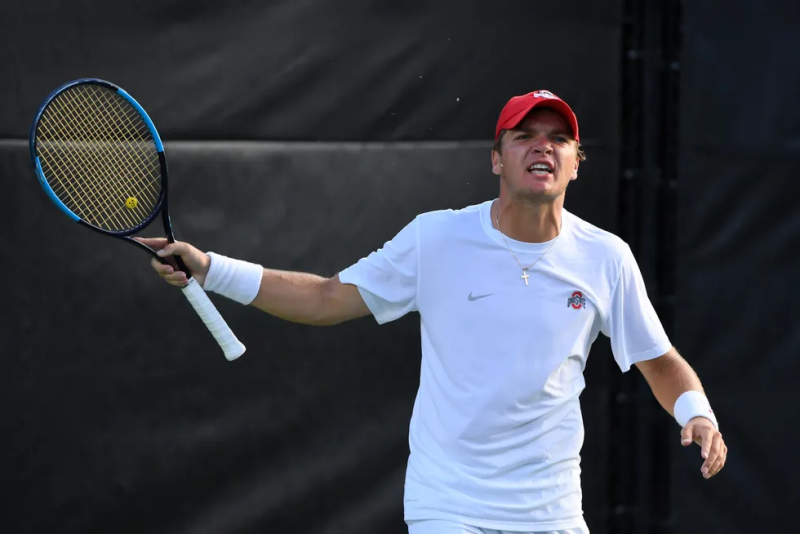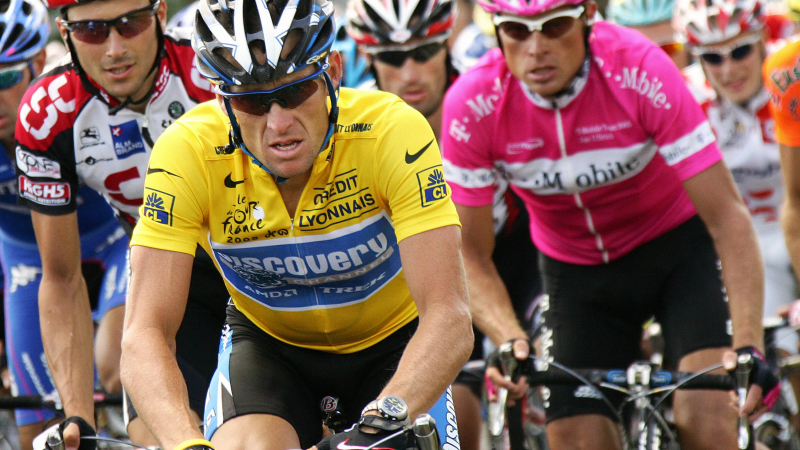College tennis has adjusted certain rules to address cheating. It's still a big problem
Only a handful of people were watching a college tennis match in April of 2019 between Ohio State and Illinois, but a mere 24 hours later, one decisive moment from that competition had become the talk of the sport.
A social media post began to circulate with a slow-motion video clip of John McNally, one of the Buckeyes’ best players, serving wide to his opponent in the deuce court during a second set tiebreaker. Illinois’ Alex Brown stretches to get his racquet on the ball, lofting a high, floating return that forces McNally to retreat.
When the ball lands, McNally immediately yells “No!” which is the universal signal for an out call. Brown immediately threw up his hands in disgust. Several of his teammates and spectators audibly gasped. They had seen the ball as obviously in, and so did those who watched the slow-motion replay that hit the Internet.
But only McNally’s call mattered. He took the point and a short while later won the match, 7-6, 7-6.
For many observers of the college tennis scene, it was sadly business as usual.
“It absolutely guts me,” said Brad Gilbert, the 1982 NCAA singles runner-up and longtime professional who reached No. 4 in the world. When Gilbert isn’t commentating on ESPN or coaching recent US Open champion Coco Gauff, he will often attend matches at Pepperdine, his alma mater, and has seen more than his share of situations that he would consider blatant cheating.

“It’s the same when I was playing, especially on big points, 30-all points, but it’s gotten to a whole other level,” Gilbert said. “Sometimes on a far sideline you can miss a call or miss one that’s really close, but the obvious cheating in college tennis has to be cleaned up.”
Aside from golf, no sport demands more honesty from its competitors to ensure a fair competition. But in tennis, you’re not policing yourself as much as refereeing your opponent.
According to the U.S. Tennis Association's code of conduct, “it is each player’s responsibility to call all balls landing on, or aimed at, (their own) side of the net” and that a player should not call a ball out “unless the player clearly sees space between where the ball hits and a line.”
Everyone learns that principle from the moment they start playing tennis in an organized fashion. Because it would be impractical to have referees keeping an eye on every junior, high school or even college match, the game is built on honesty, trust and sportsmanship.
But as players make their way up the ranks and the stakes get higher, questionable behavior inevitably becomes more common. Throughout college tennis, even for those who love it and work within it, cheating is viewed as a real problem.
“We’re the only sport, or one of the very few, that we make our own calls,” said Kentucky coach Cedric Kauffmann. “Imagine if NBA players made their own calls. It would be a mess.

“I don’t think people go in and say, ‘I want to cheat or win by cheating. I don’t think it happens like that with 99.9 percent of the players. It’s just such a tough environment that they see the ball out because they want it out so bad.”
Everyone involved in the sport accepts that mistakes can happen when players are making these split-second decisions. Balls either hit or miss lines by centimeters, often moving a high rate of speed, and sometimes our own eyes deceive us. Sports aren’t played in slow motion.
But college tennis has a real problem and over the years has adjusted certain rules to address cheating.
One example was eliminating the “let,” which occurs when a serve hits the top of the net before bouncing in. According to standard rules, that point doesn’t count and the server would essentially get a do-over. But in college, players were frequently calling lets erroneously if they got aced or missed a return. Now, the returner has to play the ball regardless if it was a let.
Another example is the increase in paid referees who have the power to overrule calls, which is now a relatively common phenomenon at the Power Five level. According to coaches, though, the quality of those officials is inconsistent at best, and often they are often cautious to overrule because they don’t always have a great vantage point.
“It’s sad that it's necessary,” said TCU coach David Roditi. “I believe the quality of the chair umpires has improved and they're paying more attention, but it’s hard for them to see it all.”
For now, there are really just two deterrents. One is the possibility that somebody will take a clip of a bad call and blow it up on social media, which happens fairly regularly during the season. But Manny Diaz, the Georgia coach who has won 29 SEC championships and four national titles, said it’s incumbent on coaches to step in and overrule a bad call if necessary.
“It’s really an eyesore,” Diaz said. “It goes to the essence of what kind of program we want to have. Each individual coach needs to lay out a baseline for what's allowed and what shouldn't be allowed within each program. If I see one of our players and I think they clearly missed a call, I’m going to intervene and try to make it right.”
The other remedy, and one that's probably used all too frequently, is the so-called “re-hook.” In other words, if a player strongly believes they've been cheated, they’ll make a blatantly bad call to reclaim the point they lost. But that only tarnishes the sport even more.
The hope is that college tennis will eventually put this ugly side of itself in the past through developments in line-calling technology, similar to what is used at many tournaments on the ATP and WTA tour. Right now, it’s too expensive for widespread use, but coaches believe that it’ll eventually become standard at the NCAA level.
Until then, cheating controversies are simply baked into the fabric of the sport.
“People send me videos of this stuff, I send them to the NCAA, I send them to the ITA when a coach is sitting there clapping right in front of a player who deliberately hooks,” Gilbert said. “To me should be an immediate suspension for the coach to send a message this isn't acceptable. Tennis is truly a great sport, it teaches you lots of values, but there’s some ridiculous cheating and some of them are serial cheaters from the same programs. It can't happen.”
Follow Dan Wolken on social media @DanWolken

Disclaimer: The copyright of this article belongs to the original author. Reposting this article is solely for the purpose of information dissemination and does not constitute any investment advice. If there is any infringement, please contact us immediately. We will make corrections or deletions as necessary. Thank you.






